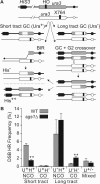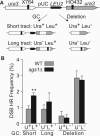Sgs1 regulates gene conversion tract lengths and crossovers independently of its helicase activity
- PMID: 16705162
- PMCID: PMC1489077
- DOI: 10.1128/MCB.00136-06
Sgs1 regulates gene conversion tract lengths and crossovers independently of its helicase activity
Abstract
RecQ helicases maintain genome stability and suppress tumors in higher eukaryotes through roles in replication and DNA repair. The yeast RecQ homolog Sgs1 interacts with Top3 topoisomerase and Rmi1. In vitro, Sgs1 binds to and branch migrates Holliday junctions (HJs) and the human RecQ homolog BLM, with Top3alpha, resolves synthetic double HJs in a noncrossover sense. Sgs1 suppresses crossovers during the homologous recombination (HR) repair of DNA double-strand breaks (DSBs). Crossovers are associated with long gene conversion tracts, suggesting a model in which Sgs1 helicase catalyzes reverse branch migration and convergence of double HJs for noncrossover resolution by Top3. Consistent with this model, we show that allelic crossovers and gene conversion tract lengths are increased in sgs1Delta. However, crossover and tract length suppression was independent of Sgs1 helicase activity, which argues against helicase-dependent HJ convergence. HJs may converge passively by a "random walk," and Sgs1 may play a structural role in stimulating Top3-dependent resolution. In addition to the new helicase-independent functions for Sgs1 in crossover and tract length control, we define three new helicase-dependent functions, including the suppression of chromosome loss, chromosome missegregation, and synthetic lethality in srs2Delta. We propose that Sgs1 has helicase-dependent functions in replication and helicase-independent functions in DSB repair by HR.
Figures







Similar articles
-
Srs2 and Sgs1-Top3 suppress crossovers during double-strand break repair in yeast.Cell. 2003 Nov 14;115(4):401-11. doi: 10.1016/s0092-8674(03)00886-9. Cell. 2003. PMID: 14622595 Free PMC article.
-
Yeast Rmi1/Nce4 controls genome stability as a subunit of the Sgs1-Top3 complex.Mol Cell Biol. 2005 Jun;25(11):4476-87. doi: 10.1128/MCB.25.11.4476-4487.2005. Mol Cell Biol. 2005. PMID: 15899853 Free PMC article.
-
The absence of Top3 reveals an interaction between the Sgs1 and Pif1 DNA helicases in Saccharomyces cerevisiae.Genetics. 2006 Oct;174(2):555-73. doi: 10.1534/genetics.104.036905. Epub 2006 Jul 2. Genetics. 2006. PMID: 16816432 Free PMC article.
-
[Functional analysis of yeast homologue gene associated with human DNA helicase causative syndromes].Kokuritsu Iyakuhin Shokuhin Eisei Kenkyusho Hokoku. 2002;(120):53-74. Kokuritsu Iyakuhin Shokuhin Eisei Kenkyusho Hokoku. 2002. PMID: 12638184 Review. Japanese.
-
Smc5/6 complex regulates Sgs1 recombination functions.Curr Genet. 2017 Jun;63(3):381-388. doi: 10.1007/s00294-016-0648-5. Epub 2016 Sep 23. Curr Genet. 2017. PMID: 27664093 Free PMC article. Review.
Cited by
-
Mus81-Eme1-dependent and -independent crossovers form in mitotic cells during double-strand break repair in Schizosaccharomyces pombe.Mol Cell Biol. 2007 May;27(10):3828-38. doi: 10.1128/MCB.01596-06. Epub 2007 Mar 12. Mol Cell Biol. 2007. PMID: 17353272 Free PMC article.
-
Effects of mutations in SGS1 and in genes functionally related to SGS1 on inverted repeat-stimulated spontaneous unequal sister-chromatid exchange in yeast.BMC Mol Biol. 2007 Dec 31;8:120. doi: 10.1186/1471-2199-8-120. BMC Mol Biol. 2007. PMID: 18166135 Free PMC article.
-
Interplay between the Smc5/6 complex and the Mph1 helicase in recombinational repair.Proc Natl Acad Sci U S A. 2009 Dec 15;106(50):21252-7. doi: 10.1073/pnas.0908258106. Epub 2009 Dec 7. Proc Natl Acad Sci U S A. 2009. PMID: 19995966 Free PMC article.
-
Sgs1 function in the repair of DNA replication intermediates is separable from its role in homologous recombinational repair.EMBO J. 2009 Apr 8;28(7):915-25. doi: 10.1038/emboj.2009.28. Epub 2009 Feb 12. EMBO J. 2009. PMID: 19214189 Free PMC article.
-
Mre11 and Ku regulation of double-strand break repair by gene conversion and break-induced replication.DNA Repair (Amst). 2007 Jun 1;6(6):797-808. doi: 10.1016/j.dnarep.2007.01.006. Epub 2007 Feb 26. DNA Repair (Amst). 2007. PMID: 17321803 Free PMC article.
References
-
- Adams, M. D., M. McVey, and J. J. Sekelsky. 2003. Drosophila BLM in double-strand break repair by synthesis-dependent strand annealing. Science 299:265-267. - PubMed
-
- Ahmad, F., C. D. Kaplan, and E. Stewart. 2002. Helicase activity is only partially required for Schizosaccharomyces pombe Rqh1p function. Yeast 19:1381-1398. - PubMed
-
- Ajima, J., K. Umezu, and H. Maki. 2002. Elevated incidence of loss of heterozygosity (LOH) in an sgs1 mutant of Saccharomyces cerevisiae: roles of yeast RecQ helicase in suppression of aneuploidy, interchromosomal rearrangement, and the simultaneous incidence of both events during mitotic growth. Mutat. Res. 504:157-172. - PubMed
-
- Bennett, R. J., J. L. Keck, and J. C. Wang. 1999. Binding specificity determines polarity of DNA unwinding by the Sgs1 protein of S. cerevisiae. J. Mol. Biol. 289:235-248. - PubMed
Publication types
MeSH terms
Substances
Grants and funding
LinkOut - more resources
Full Text Sources
Molecular Biology Databases
